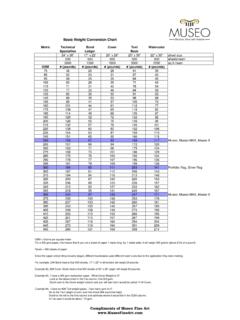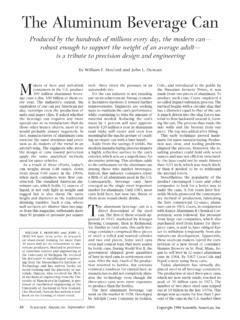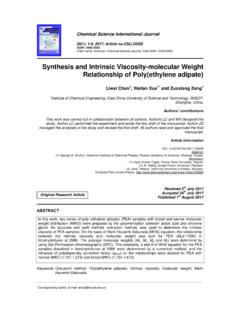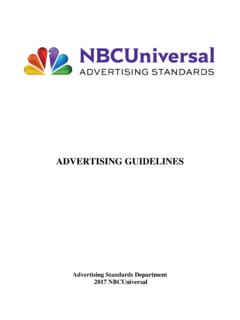Transcription of Guidelines on Optimal feeding of low birth- weight infants ...
1 Guidelines on 2011 Optimal feeding of low birth- weight infants in low-and middle-income countries Optimal feeding of low birth- weight infants in low-and middle-income countries Guidelines on 2011 WHO Library Cataloguing-in-Publication Data Guidelines on Optimal feeding of low birth- weight infants in low- and middle-income countries. nutrition. , Low birth weight . requirements. methods. food. countries. Health Organization. ISBN 978 92 4 154836 6 (NLM classification: WS 120) World Health Organization 2011 All rights reserved. Publications of the World Health Organization are available on the WHO web site ( ) or can be purchased from WHO Press, World Health Organization, 20 Avenue Appia, 1211 Geneva 27, Switzerland (tel.)
2 : +41 22 791 3264; fax: +41 22 791 4857; e-mail: Requests for permission to reproduce or translate WHO publications whether for sale or for noncommercial distribution should be addressed to WHO Press through the WHO web site ( ). The designations employed and the presentation of the material in this publication do not imply the expression of any opinion whatsoever on the part of the World Health Organization concerning the legal status of any country, territory, city or area or of its authorities, or concerning the delimitation of its frontiers or boundaries. Dotted lines on maps represent approximate border lines for which there may not yet be full agreement. The mention of specific companies or of certain manufacturers products does not imply that they are endorsed or recommended by the World Health Organization in preference to others of a similar nature that are not mentioned.
3 Errors and omissions excepted, the names of proprietary products are distinguished by initial capital letters. All reasonable precautions have been taken by the World Health Organization to verify the information contained in this publication. However, the published material is being distributed without warranty of any kind, either expressed or implied. The responsibility for the interpretation and use of the material lies with the reader. In no event shall the World Health Organization be liable for damages arising from its use. CONTENTS Page Acknowledgements Abbreviations and glossary Executive summary I II 1 Introduction 5 Scope of the Guidelines 7 Methodology 10 Recommendations 16 Field testing of Guidelines 46 Implementation plan 46 References 47 Annexes 1 Detailed GRADE profiles summarizing evidence 2 Summary of individual research studies which formed the basis of recommendations feeding of LBW infants ACKNOWLEDGEMENTS Many individuals made significant contributions to the development of these Guidelines .
4 Ramesh Agarwal, Zulfiqar Bhutta, Karen Edmond, Sandra Lang, Indira Narayanan, Samuel Newton, Vinod Paul, Muhammad Sohail Salat, Mar a Asunci n Silvestre, Nalini Singhal and Anthony Williams served as members of the Guidelines Development Group. WHO staff members involved included: Rajiv Bahl, Carmen Casanovas, Bernadette Daelmans, Ornella Lincetto, Jeevasankar Mari, Jose Martines and Randa Saadeh. Felicity Savage King participated in writing the draft Guidelines ; Peggy Henderson edited the final draft. I feeding of LBW infants ABBREVIATIONS AND GLOSSARY CI Confidence interval CLD Chronic lung disease DARE Cochrane database of abstracts of reviews of effectiveness dl Decilitre ELBW Extremely low birth weight ES Effect size g Gram GDG Guideline development group GRADE System for grading the quality of evidence and the strength of recommendations HIV Human immunodeficiency virus IMCI Integrated management of childhood illness IMPAC Integrated management of pregnancy and childbirth IQ Intelligence quotient
5 International unit kg Kilogram l Litre LBW Low birth weight mg Milligram ml Millilitre MD Mean difference NEC Necrotizing enterocolitis OR Odds ratio Palladai Cup with a beak PICO Population, intervention, comparison, outcome RCT Randomized controlled trial RDA Recommended daily allowance ROP Retinopathy of prematurity RR Relative risk SD Standard deviation SGA Small for gestational age TPN Total parenteral nutrition VLBW Very low birth weight WHO World Health Organization WMD Weighted mean differenceII feeding of LBW infants 1 EXECUTIVE SUMMARY Low birth weight (LBW) has been defined by the World Health Organization (WHO) as weight at birth less than 2500 g.
6 The global prevalence of LBW is , which means that about million such infants are born each year, of them in developing countries. There is significant variation in LBW rates across the United Nations regions, with the highest incidence in South-Central Asia ( ) and the lowest in Europe ( ). LBW can be a consequence of preterm birth (defined as birth before 37 completed weeks of gestation), or due to small size for gestational age (SGA, defined as weight for gestation <10th percentile), or both. In addition, depending on the birth weight reference used, a variable but small proportion of LBW infants are born at term and are not SGA. Intrauterine growth restriction, defined as a slower than normal rate of fetal growth, is usually responsible for SGA. LBW thus defines a heterogeneous group of infants : some are born early, some are born at term but are SGA, and some are both born early and SGA.
7 Being born with LBW is generally recognized as a disadvantage for the infant. LBW infants are at higher risk of early growth retardation, infectious disease, developmental delay and death during infancy and childhood. Countries can substantially reduce their infant mortality rates by improving the care of LBW infants . Experience from developed and low- and middle-income countries has clearly shown that appropriate care of LBW infants , including feeding , temperature maintenance, hygienic cord and skin care, and early detection and treatment of complications, can substantially reduce mortality in this highly vulnerable group. Interventions to improve feeding are likely to improve the immediate and longer-term health and well-being of the individual infant and have a significant impact on neonatal and infant mortality levels in the population.
8 Better feeding was one of the first interventions for preterm babies in the 1960s in the United Kingdom and was associated with reduced case fatality in hospitals before the advent of intensive care. The objective of these Guidelines is to improve the quality of care received by LBW infants in developing countries through improved capacity of health workers. These Guidelines focus on the feeding of clinically stable LBW infants in low-and middle income countries. They do not specifically address the feeding of infants with a birth weight less than kg (known as extremely LBW, ELBW), who are often clinically unstable and may require parenteral nutrition. Guidance on the management of clinically unstable infants is addressed in other WHO documents. The guideline development group identified 18 research questions to be of the highest priority for development of recommendations.
9 Most of the questions are relevant to all LBW infants (birth weight less than kg) but some are specific to very LBW (VLBW) infants (birth weight less than kg). The questions do not specifically address ELBW infants . For each question, the following four outcomes were considered to be critical: mortality, severe morbidity, neurodevelopment and anthropometric status. Benefits and harms in critical outcomes formed the basis of the recommendations for each question. feeding of LBW infants 2 Studies from developing and developed countries that included infants with a birth weight less than 2500 g or gestation less than 37 weeks were considered for inclusion in this review. Efforts were made to identify relevant non-English language articles and abstracts also.
10 A standardized form was used to extract relevant information from studies. Systematically extracted data included: study identifiers, setting, design, participants, sample size, intervention or exposure, control or comparison group, outcome measures and results. The following quality characteristics were recorded for all studies: allocation concealment or risk of selection bias (observational studies), blinding of intervention or observers or risk of measurement bias, loss to follow up, intention to treat analysis or adjustment for confounding factors, and analysis adjusted for cluster randomization (the latter only for cluster-randomized controlled trials, RCTs). We used a modified GRADE approach for assessing the quality of evidence and the recommendations (for details, see Methodology section).












![ABSTRACT arXiv:1409.1556v6 [cs.CV] 10 Apr 2015](/cache/preview/4/e/0/e/4/4/2/c/thumb-4e0e442c20fc4f8e108fa20a1095af07.jpg)




